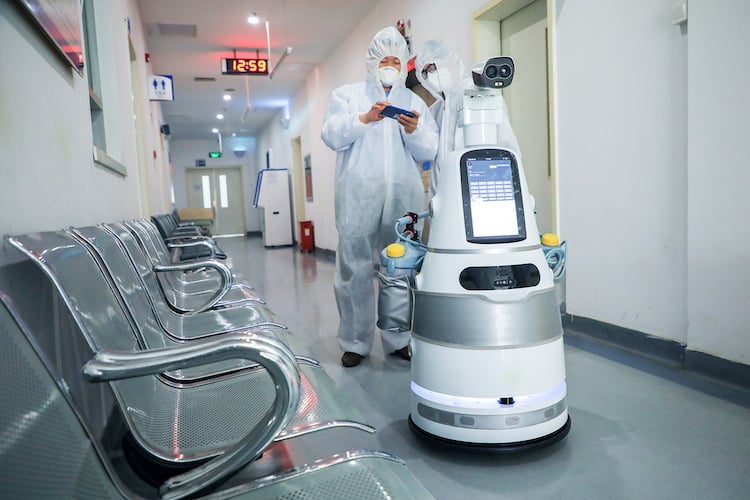![]()
In August, about half a year since the coronavirus pandemic first caused businesses, schools and banks to shut their doors, organizations around the country are tentatively reopening. Concerns remain, however, about how possible it will be to ensure that reopening is safe for students and consumers.
Safety measures like regular sanitizing and temperature-measurement checkpoints are two options organizations are using to keep operations safe. However, carriers without symptoms can spread the coronavirus — meaning temperature checks alone won't halt the virus. Because the virus can also spread via airborne droplets in enclosed indoor spaces, surface sanitizing also may not be enough.
One of the best ways to stop the spread of the virus is to identify who may have it and alert anyone who's come into contact with them — a strategy known as contact tracing. New tracking technology is making it possible for individual organizations to launch contact-tracing initiatives. This tech for tracking COVID may make reopening procedures and normal operations much safer for sectors like education, banking, and hospitality.
Schools
For most schools, improved sanitation practices and temperature-tracking checkpoints will form the foundation of their COVID-prevention strategy.
Some school districts are also considering the use of remote surveillance tech that can track students as they move across campus. This technology can cover areas where large numbers of students congregate and potentially give administrators better information on who to send home if someone becomes sick.
More advanced tech may be able to detect when students or faculty have removed their masks or are standing too close together. Tracking student and staff behavior with this tech could help enforce social distancing policies and possibly break the chain of transmission from person to person.
Some educators and privacy experts are concerned, however, that schools will try to keep using the tech after the crisis has passed.
Banking
Banks and other financial institutions have been uniquely impacted by COVID-19, with shifting legal standards in the wake of the crisis's early days affecting everything from unemployment insurance to tax law to land-use approvals.
Now, as these businesses attempt to reopen branches and offices, they face the challenge of keeping employees and customers safe.
As with schools, new tech may help. UBI Banca — which is the fifth-largest bank in Italy — developed an in-house contact-tracing app, UBISafe, for use by the company's employees. The app works like most contact-tracing platforms, alerting users if they've come in recent contact with another user who has reported symptoms of COVID-19.
UBI Banca configured the program so that the app was automatically installed on company smartphones, which make up 40% of phones used by company employees. The business has plans to require that workers download the app onto their personal phones, as well.
UBI Banca's CIO, Marco Cecchella, is confident the company can get the app on most employees' phones. If so, it could effectively track the spread of the virus throughout the bank's offices. Doing so could allow the company to halt disease transmission and provide a possible model for virus control for other banks and credit unions.
Restaurants and Hospitality
While all sectors of the economy have felt the impact of COVID-19, it has hit the hospitality industry particularly hard. Hotels, restaurants and bars face a serious challenge — how do you serve customers safely during a pandemic?
For many restaurants and bars, the answer has been shifting away from in-restaurant dining to service that minimizes contact between staff and customers — like no-contact delivery and curbside pickup. For hotels and other businesses that provide lodging, however, safe service is more complicated.
New tech in the hotel industry, like digital concierge bots, is helping the sector track guests feeling under the weather. The concierge bot, which hotel guests activate when they check in, allows visitors to place requests for towels, order room service or book a spa appointment without needing to make contact with hotel staff.
In one luxury hotel in Singapore, the concierge bot also includes a new self-reporting "health declaration" function that allows guests to declare if they're feeling sick. With this function, the hotel staff can know which guests may be ill. This information can help them provide visitors with services that will allow them to self-quarantine and alert guests who may have come into contact with those potential carriers.
Contact-Tracing Tech May Help as Businesses and Organizations Reopen
As the economy reopens, organizations of all types face the challenge of protecting their employees and customers. New contact-tracing tech, like apps and digital hotel concierges, may help.
The pandemic will probably last well into the future, meaning these organizations need new strategies for managing the spread of the virus and tracking COVID on their premises. While this tech may not fully prevent the spread of the coronavirus, it will likely keep customers and employees informed and help institutions enforce self-quarantine and disrupt virus transmission
Discover more Technological resources with RobotLAB!

Autor:



